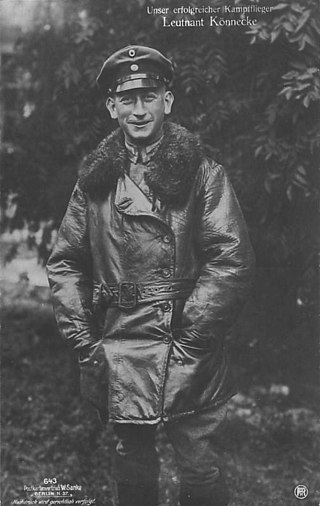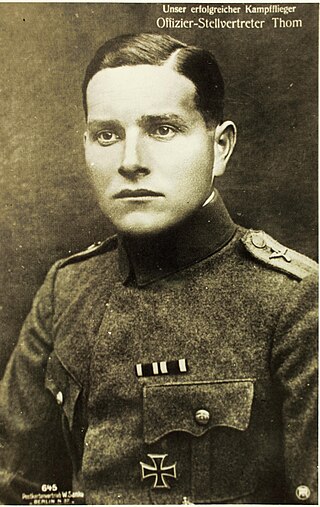
LeutnantKarl Allmenröder was a German World War I flying ace credited with 30 aerial victories. The medical student son of a preacher father was seasoned in the trenches as an 18-year-old artilleryman in the early days of the First World War, earning promotion via battlefield commission to Leutnant on 30 March 1915. After transferring to aviation and serving some time as an artillery spotter in two-seater reconnaissance airplanes, he transferred to flying fighter aircraft with Jagdstaffel 11 in November 1916. As Manfred von Richthofen's protege, Karl Allmenröder scored the first of his 30 confirmed victories on 16 February 1917. Flying a scarlet Albatros D.III trimmed out with white nose and elevators, Allmenröder would score a constant string of aerial victories until 26 June 1917, the day before his death. On 27 June 1917, Karl Allmenröder fell to his death near Zillebeke, Belgium. His posthumous legacy of patriotic courage would later be abused as propaganda by the Nazis.

Rittmeister Carl Bolle was a German fighter ace with 36 aerial victories during World War I and a recipient of the Order Pour le Mérite, Prussia's highest award for bravery. He became a Jagdstaffel commander during that war, and an advisor to the Luftwaffe during World War II.

Emil Thuy, Pour le Merite, Württemberg's Order of Military Merit, House Order of Hohenzollern, Iron Cross First and Second Class, was one of the leading German fighter aces of World War I, with 35 victories. After the war, he was an adviser to the Finnish air force and was involved in the secret origins of the Luftwaffe within the Soviet Union.

LeutnantOtto Könnecke PLM, MMC, HoH, IC, was a leading German fighter ace of World War I with 35 victories. He was one of only five pilots to receive Germany's highest decorations for both enlisted pilot and officer. He later became one of the founding pilots of Deutsche Luft Hansa and assisted in development of the new Luftwaffe.

Walter Kuno Reinhold Gustav von Bülow-Bothkamp was a German fighter ace from an aristocratic family who was credited with 28 victories. After entering World War I as a hussar, he transferred to the Imperial German Air Service. He was a recipient of the Pour le Merite, Prussia's highest award for valor, as well as the Knight's Cross of the Military Order of Saint Henry, Saxony's highest award for valor. On 6 January 1918, he was killed in action.

Leutnant Karl Thom, was a German World War I flying ace credited with 27 victories. He was decorated with both his nation's highest decorations for valor, the Military Merit Cross as an enlisted soldier, and the Pour le Mérite after he was commissioned as an officer. He was one of only four German aces of World War I to achieve this double award.
LeutnantHans Martin Pippart Iron Cross was a pioneer aircraft manufacturer and early pilot. As a World War I German fighter ace he was credited with 22 victories.
Leutnant August Hanko was a German World War I flying ace credited with five aerial victories.
Leutnant Gustav Frädrich was a German World War I flying ace credited with six aerial victories.
Leutnant Heinrich Henkel was a World War I flying ace credited with eight aerial victories.
Leutnant Hans Gottfried von Häbler was a World War I flying ace credited with eight aerial victories.
LeutnantWalter Böning was a German World War I flying ace from the Grand Duchy of Oldenburg credited with 17 aerial victories. He began his World War I military service as an infantryman. He distinguished himself by winning both the Gold Medal for Bravery and the Second Class Iron Cross. He then transferred to aviation duty, training originally as a reconnaissance pilot before advancing to become a fighter pilot. Between 6 April 1917 and 30 May 1918, he was credited with 17 aerial victories. On 31 May 1918, he survived a midair collision while being attacked by British fighters. Although he coaxed his damaged machine home, the serious leg wound he had suffered sidelined him through war's end.
LeutnantHans Böhning, Iron Cross, was a German World War flying ace credited with 17 aerial victories. He served the German Empire first as an artilleryman, then as an aerial observer for artillery, as a fighter pilot, and finally as the Staffelführer of a fighter squadron.
Leutnant Ludwig Hanstein HOH, Bavaria's MMO was a World War I flying ace credited with 16 aerial victories.
Vizefeldwebel Karl Bohnenkamp was a World War I flying ace credited with 15 aerial victories. He scored his first victory on 21 September 1917 and continued through 28 October 1918. His 15 victories made him the leading ace in his squadron. He was awarded the Military Merit Cross on the latter date.

LeutnantAlbert Dossenbach was a World War I flying ace credited with 15 aerial victories.
Leutnant Heinrich Arntzen was a German World War I flying ace credited with eleven aerial victories.

Leutnant Leopold Anslinger was a German World War I flying ace credited with ten aerial victories while flying on the Russian Front.
Leutnant Hans Hoyer was a German World War I soldier who was decorated as an artilleryman before turning to aviation. As a flyer, he became an ace credited with eight confirmed and three unconfirmed aerial victories before being killed in action while fighting.

LeutnantHermann Habich was one of the original pilots in the Imperial German Air Service, having earned his brevet two months before World War I began. He is credited with having downed and killed French aviation pioneer Roland Garros. Habich scored seven victories in all, becoming a flying ace. He joined the Luftwaffe in the 1930s and served in World War II.










